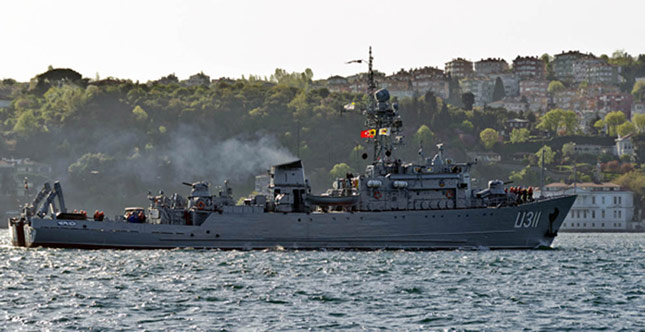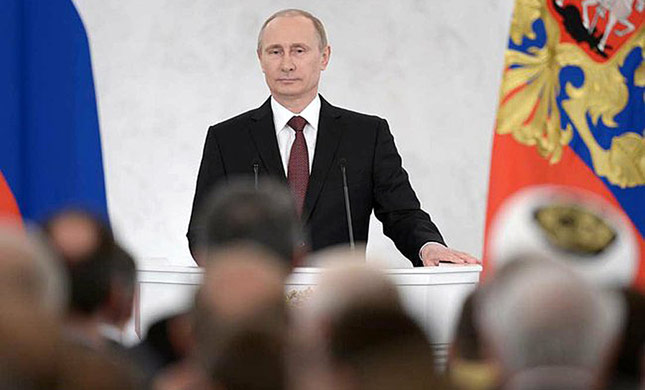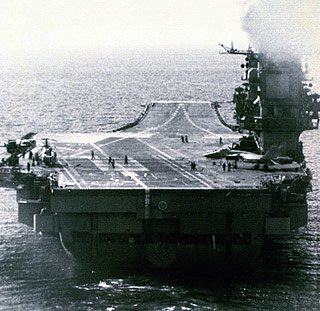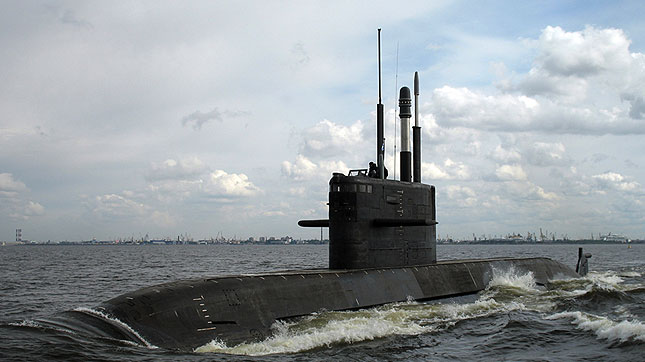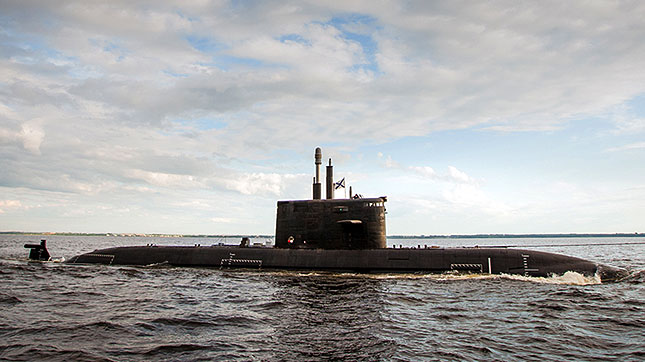FORGET THE SEA OF AZOV – NATO Should Help Ukraine by Exploiting Strategic Leverage Elsewhere
Obviously the international community should do all it can to respond resolutely in the face of Russian aggression in the Sea of Azov, but the reality is that it is considered by Moscow to be mare nostrum. That may not be morally or legally correct, but it is now a cold, hard fact.
The request by Ukrainian President Petro Poroshenko for NATO vessels to be sent into the Sea of Azov is understandable, but unlikely to happen. The Sea of Azov is not even considered international waters but is, rather, shared between Russia and Ukraine. Only vessels flying the flags of Russia and Ukraine may navigate freely in the Sea of Azov, though it now appears Moscow believes its vessels alone should have that right.
The Alliance would be well advised to forget about direct intervention in the Sea of Azov altogether, unless it wants to go toe-to-toe with the Russians and suffer heavy casualties in a conflict that could rapidly escalate with no good outcome for anyone.
Pressure can still be applied in the Black Sea – and NATO regularly deploys task groups and individual vessels close to Russian shores – but it should never be overlooked that it is an area where (like the South China Seas these days) ‘big boys rules’ apply.
Utmost vigilance, constant readiness for aggression from Russia and fine decision-making are needed during near-to-the-knuckle encounters.
The British destroyer HMS Duncan’s encounter with multiple Russian strike jets last May and the even more recent close call between a US Navy intelligence-gathering aircraft and a Russian fighter jet demonstrated this.

The British destroyer HMS Duncan exercises with the Bulgarian frigate BGS Drazki during the May 2018 deployment in which the Royal Navy vessel was harassed by Russian aircraft. Photo: Royal Navy.
In the risky game of countering Russia’s pursuit of anti-access, area denial – or A2/AD as it is called in modern military speak – there is no way that either Ukraine or NATO can win in an enclosed sea dominated by Russia geographically, such as the Sea of Azov.
There is past evidence of why that is the case. While for the most part the Russian Navy recorded a less than impressive record during WW1 and WW2 – ceding the main offensive effort at sea to allies and showing little gratitude at the time (perhaps due to the heavy priced paid on land by the Soviet Union) – there was a notable exception.
That was the Russian Navy gaining the upper hand in the Black Sea during WW1 – giving the Turks a rough time and also making life miserable for German U-boat interlopers – achieving a good measure of success with mine warfare, something it also used to good effect in the Baltic during the same conflict.
In WW2 the Soviets in the end prevailed in the Black Sea primarily due to the efforts of their army and air force, the Axis fleets suffering the problem of weak surface forces and Germany only being able to send in smaller U-boats overland via rail shipments, due to neutral Turkey controlling access to the sea.
And today the Russians not only have an array of sophisticated mines at their disposal – ideal for use in the littoral waters of the Black Sea and Sea of Azov and sewing confusion in the Turkish Strait – they can achieve local air superiority and have formidable land-based missile systems. They aspire to the same thing in the Baltic, using their Kaliningrad enclave to dominate its southern end.
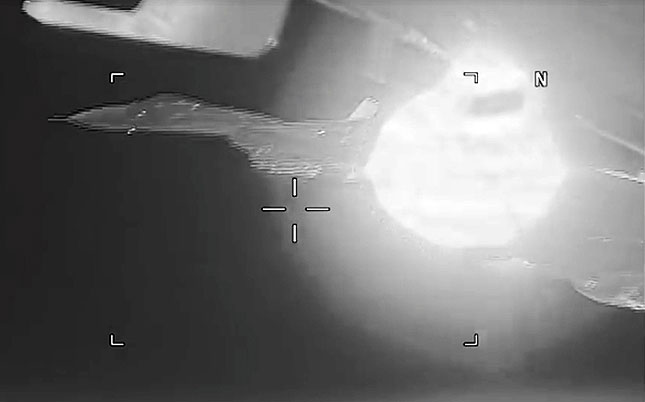
A Russian fighter jet comes dangerously close to a US Navy intelligence-gathering aircraft over the Black Sea. Image: US DoD.
In the Black Sea the naval base at Sevastopol is home to some of the better surface combatants and also cutting edge Improved Kilo Class submarines. Some have already been used in anger, to conduct cruise missile bombardments of targets in Syria.
So, unless NATO and the Ukraine want to push the all-out war button to overwhelm the Russian home team advantage, what else can be done? NATO and the rest of the international community can best help Ukraine and Alliance members states menaced by the Kremlin’s aggressive hybrid warfare by sending in units to hold the line in the Black Sea, while deploying Alliance naval forces elsewhere to decisive effect.
It is true that in the conventional sense, across the board, the Russian Navy would currently be no match for NATO in full-on conflict, but Moscow will do all it can to avoid that. It will seek to use its submarines – which now possess capabilities not far off the best NATO can offer – along with its new deep ocean spy vessels, corvettes and frigates in places and at times of its own choosing, careful not to over-reach itself and with limited objectives (within the doctrine of ‘war in peace’).
Today it is control of the Sea of Azov, probably as a preliminary to a drive by ‘rebel Ukrainian’ forces along its northern coast to link up Russian itself with the Crimea, ensuring access to the key naval base at Sevastopol and other military bases in the peninsula. Access to the Mediterranean and protecting Russia’s southern flank is an enduring strategic objective for Russia, hence the heavy involvement in Syria where there is a major Russian naval support facility.
Occasionally Russia cocks a snook at the West by sending submarines into the Irish Sea, or deploys them to poke about in the Baltic, or long-range maritime strike aircraft test NATO air defences. Its surface vessels and (surfaced) submarines quite legitimately pass close to NATO coastlines while heading south to Syria from the Baltic or the Northern Fleet bastions in the Arctic.
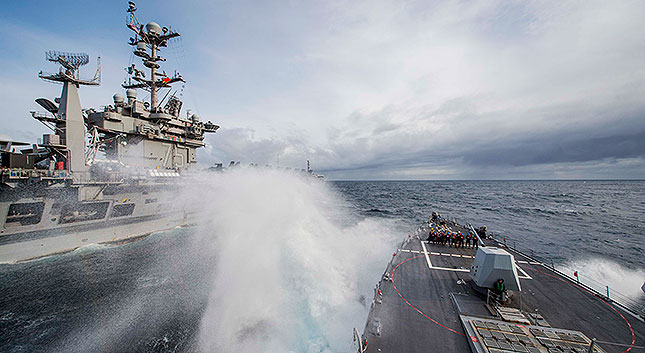
Arleigh Burke Class destroyer USS Farragut conducts a replenishment-at-sea alongside the aircraft carrier USS Harry S. Truman during the carrier’s most recent deployment into the North Atlantic. Photo: US Navy.
NATO can regain the initiative, put the Russians off balance and also keep them tied down by returning to the tried and test strategy that won the Cold War. NATO, which in this case means the US Navy, the Royal Navy and Marine Nationale, should deploy nuclear-powered attack submarines (SSNs) into the North Atlantic and Arctic to reinforce the message that those international waters will never be the exclusive preserve of the Russians. NATO surface vessels should also return to establishing freedom of navigation in those seas, including the Barents.
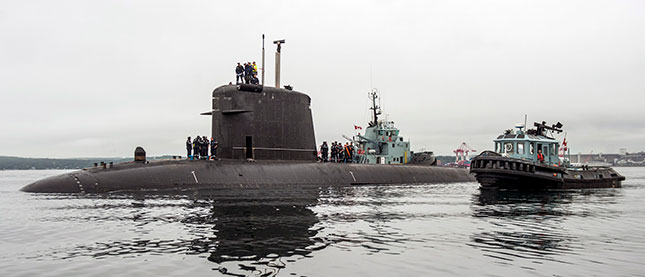
The French Navy (Marine Nationale) nuclear-powered attack submarine FNS Perle calls at a Canadian naval base during a 2016 ASW exercise in the North Atlantic. Photo: Canadian DND.
The recent Exercise Trident Juncture off Norway saw the first deployment into Arctic waters by a US Navy Carrier Strike Group (CSG) in decades, while a little publicised element of the same exercise was the presence of British and French SSNs during Anti-submarine Warfare (ASW) training alongside Norwegian conventional boats. In the near future the Royal Navy should take a leaf out of its own Cold War playbook, when it used to deploy its last big deck carrier, HMS Ark Royal, way up into the N. Atlantic, and resume such operations.
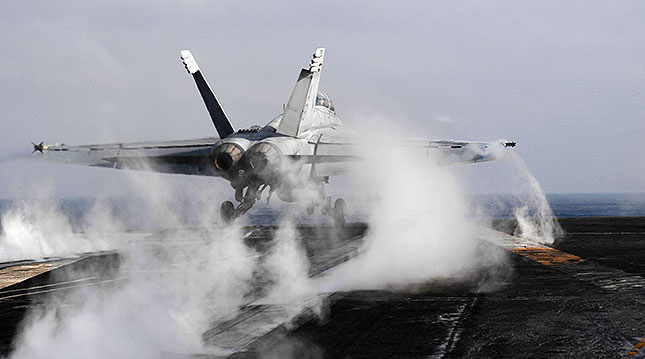
A Super Hornet strike jet launches from USS Harry S. Truman during her autumn 2018 deployment in the North Atlantic. Photo: US Navy.
Aside from giving the Russians something to think about in the High North – tying down their best naval assets and keeping them stretched and pushed very hard up there – any Russian surface warships and submarines venturing further south and into the Mediterranean should not be just playfully shadowed by harmless Offshore Patrol Vessels (OPVs). They should be relentlessly trailed, hailed and interrogated by destroyers, frigates and aircraft. NATO submarines should also trail them.
In other words Moscow’s naval units should be subjected to exactly the same treatment the Russians mete out to NATO and allied vessels, and all of course conducted legally within international waters and using (safe) norms of behaviour. NATO units will undoubtedly face severe provocation in return but must keep a cool head.
There will inevitably be risks, just as there were during the Cold War, but that is what navies are there for – laying down the red lines at sea that aggressors must not cross, in order to keep the rest of us safe. To not respond in the fashion suggested will only encourage Moscow (especially in the Black Sea, Baltic and Arctic) and its strategic pal Beijing (in the South China Sea and further afield) to close off more of the open commons of the sea to use for their own ends and coerce other nations.
